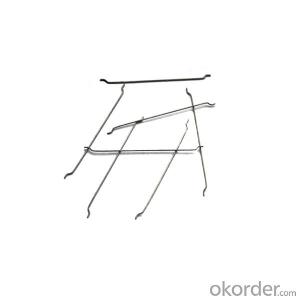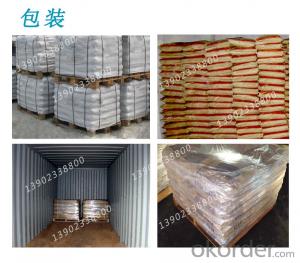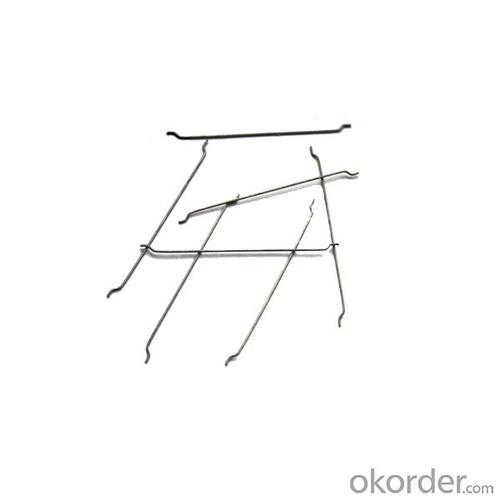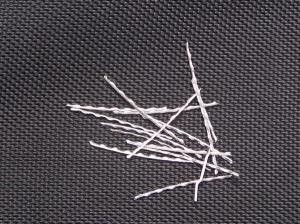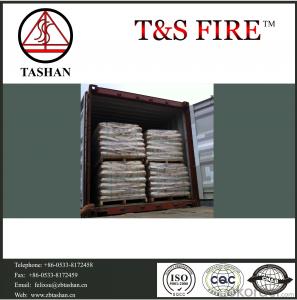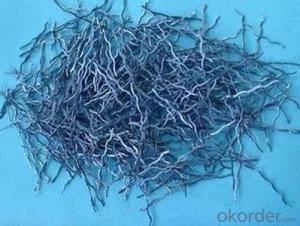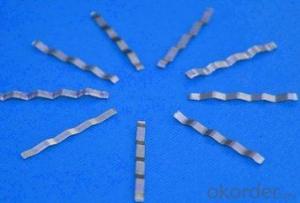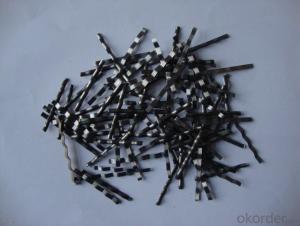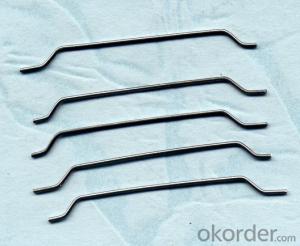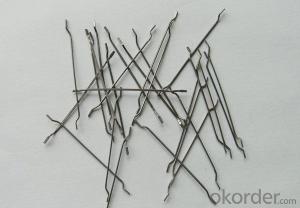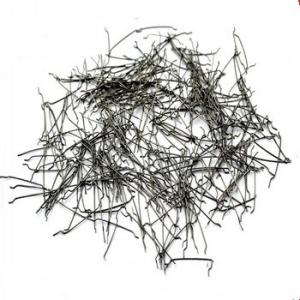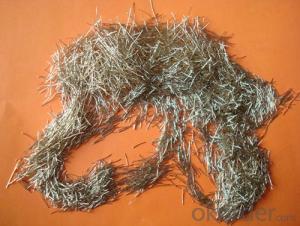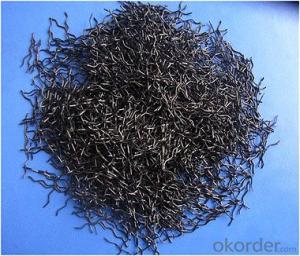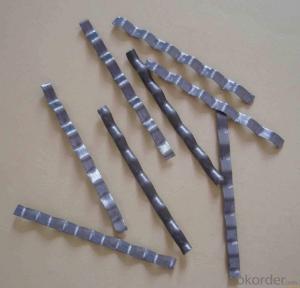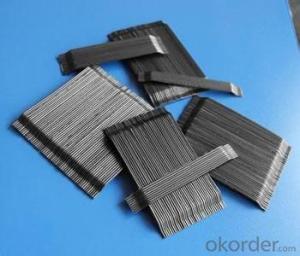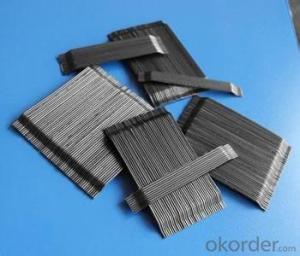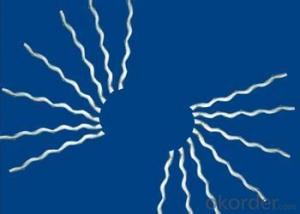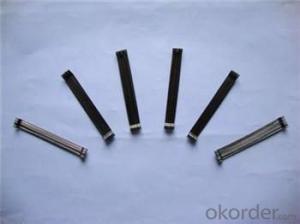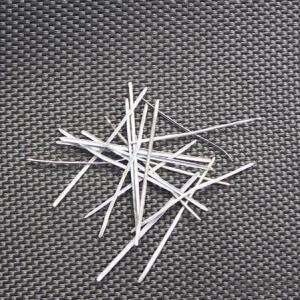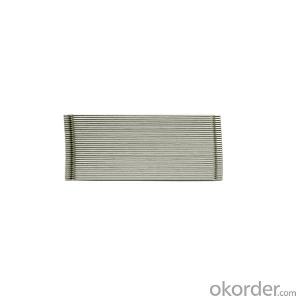Melt Extract Stainless Steel Fiber for High Quality Concrete Reinforcement
- Loading Port:
- Tianjin
- Payment Terms:
- TT OR LC
- Min Order Qty:
- 1 m.t.
- Supply Capability:
- 600 m.t./month
OKorder Service Pledge
Quality Product, Order Online Tracking, Timely Delivery
OKorder Financial Service
Credit Rating, Credit Services, Credit Purchasing
You Might Also Like
Quick Details
Place of Origin: Tianjin, China (Mainland)
- Model Number: 0.75
Material: Steel
Production Process: Cold drawn
Fiber Lengh: 60
Type: 1
Compressive Strength: >1200MPa
Aspect ratio: 80
Standard: ASTM A820M-11
Section Shape: Circular
Application: Concrete Reinforcement
- Product application: Floor
Packaging & Delivery
| Packaging Details: | 20 kg/Bag,50 bags/Pallet or 1,000kg/ Bulk Bag |
|---|---|
| Delivery Detail: | 1 Month |
Product Description
| Diameter | 0.75 | mm | 0.03 | in |
| Length | 60.00 | mm | 2.35 | in |
| Aspect Ratio | 80 | |||
| Tensile strength | 1200 MPa | |||
| Type | Cold drawn Steel Fiber | |||
| End | Hooked-end Steel Fiber | |||
| Glued/Loose | Glued Steel Fiber | |||
| Bending Angle | 45°(min.30°) | |||
| Usage & Performance | Floor:Trafficked areas and Industrial floors | |||
| Shotcrete :Slope stabilization and Final lining | ||||
| Precast concrete:Pipe and Railway sleepers | ||||
| Packing | Standard Export Pallet Packing | Bag Packing | 20 kg/Bag,50 bags/Pallet | |
| Bulk Packing | 1,000kg/ Bulk Bag | |||
| Loading Quantity | 20’GP | 20-25 Tonne/Tonnes | ||
| 40’GP | 25-27 Tonne/Tonnes | |||
| 40’HQ | 25-27 Tonne/Tonnes | |||
| MOQ | 1 kg for trial order | |||
| Supply Ability | 10,000 Tonne/Tonnes per Year | |||
| Payment Terms | T/T or L/C at sight | |||
| Delivery Time | Within 15 days after receiving deposit or original L/C at sight | |||
| Certification | ISO9001:2000, CE, | |||
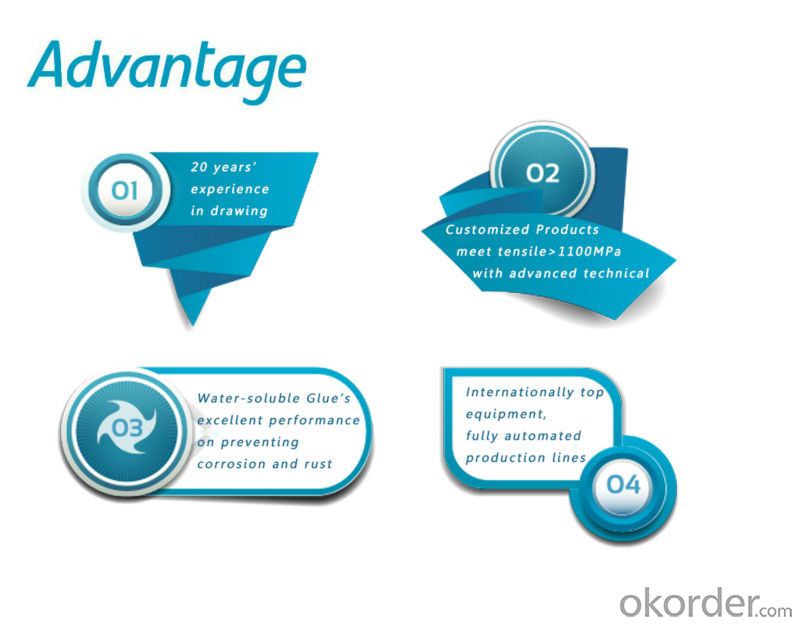
| Product | Diameter | Length mm/in | Aspect Ratio | Type | Packing |
| G-6030 | 0.5 mm (0.0197 in) | 30 mm (1.1811 in) | 60 | Glued | 20 kg/Bag, or 1,000kg/ Bulk Bag |
| G-6535 | 0.55 mm (0.0217 in) | 35 mm (1.3780 in) | 65 | Glued | 20 kg/Bag, or 1,000kg/ Bulk Bag |
| G-6035 | 0.6 mm (0.0236 in) | 35 mm (1.3780 in) | 60 | Glued | 20 kg/Bag, or 1,000kg/ Bulk Bag |
| G-8060 | 0.75 mm (0.0295 in) | 60 mm (2.3622 in) | 80 | Glued | 20 kg/Bag, 50 bags/Pallet |
| G-6060 | 0.9 mm (0.0354 in) | 60 mm (2.3622 in) | 60 | Glued | 20 kg/Bag, 50 bags/Pallet |
| G-6030 | 0.5 mm (0.0197 in) | 30 mm (1.1811 in) | 60 | Loose | 20 kg/Bag, or 1,000kg/ Bulk Bag |
| G-6535 | 0.55 mm (0.0217 in) | 35 mm (1.3780 in) | 65 | Loose | 20 kg/Bag, or 1,000kg/ Bulk Bag |
| G-6035 | 0.6 mm (0.0236 in) | 35 mm (1.3780 in) | 60 | Loose | 20 kg/Bag, or 1,000kg/ Bulk Bag |
| G-8060 | 0.75 mm (0.0295 in) | 60 mm (2.3622 in) | 80 | Loose | 20 kg/Bag, 50 bags/Pallet |
| G-6060 | 0.9 mm (0.0354 in) | 60 mm (2.3622 in) | 60 | Loose | 20 kg/Bag, 50 bags/Pallet |
- Q: Can melt extract stainless steel fiber be used in tunnel lining rehabilitation applications?
- Yes, melt extract stainless steel fiber can be used in tunnel lining rehabilitation applications. Stainless steel fibers are known for their high strength, corrosion resistance, and durability, making them suitable for use in various construction and rehabilitation projects. In tunnel lining rehabilitation, these fibers can be added to the concrete mix to enhance its mechanical properties and improve its resistance to cracking and spalling. The stainless steel fibers help to increase the flexural strength of the concrete, reduce shrinkage, and enhance its overall durability. Additionally, the fibers can also provide additional reinforcement to the tunnel lining, improving its resistance to seismic activity and other external forces. Overall, the use of melt extract stainless steel fiber in tunnel lining rehabilitation applications can help to prolong the lifespan of the tunnel, increase its structural integrity, and reduce the need for frequent maintenance and repairs.
- Q: Is melt extract stainless steel fiber compatible with all types of concrete curing methods?
- No, melt extract stainless steel fiber is not compatible with all types of concrete curing methods. While stainless steel fibers can enhance the mechanical properties of concrete, their effectiveness may vary depending on the curing method used. For example, if the concrete is subjected to high-temperature curing methods such as steam curing or autoclaving, the melt extract stainless steel fibers may experience a reduction in their mechanical properties due to the high heat. This can lead to a decrease in the overall performance of the concrete. On the other hand, if the concrete is cured using traditional methods such as air curing or water curing, the melt extract stainless steel fibers can be compatible and provide beneficial reinforcement to the concrete. These fibers can improve the tensile strength, crack resistance, and durability of the concrete, leading to enhanced performance and longevity. It is important to consider the specific curing method and its impact on the melt extract stainless steel fibers when using them in concrete applications. Consulting with experts and conducting proper testing can help determine the compatibility and effectiveness of these fibers in different curing methods.
- Q: Can melt extract stainless steel fiber be used in the construction of precast concrete walls?
- Yes, melt extract stainless steel fiber can be used in the construction of precast concrete walls. Melt extract stainless steel fibers are specifically designed to enhance the mechanical properties and durability of concrete. They are commonly used to improve the tensile strength, flexural strength, and crack resistance of concrete structures. When added to the concrete mix, the stainless steel fibers create a three-dimensional reinforcement network within the concrete matrix. This network helps to distribute the internal stresses and restrain crack propagation, resulting in improved structural integrity and longevity of the precast concrete walls. Furthermore, melt extract stainless steel fibers have excellent corrosion resistance and can withstand exposure to harsh environmental conditions, such as high temperatures, chemicals, and moisture. This makes them suitable for use in precast concrete walls, which may be subjected to various external factors. In conclusion, melt extract stainless steel fibers can effectively enhance the performance and durability of precast concrete walls. Their use can lead to stronger, more resilient structures that can withstand the demands of construction and provide long-lasting benefits.
- Q: How does melt extract stainless steel fiber contribute to the post-cracking behavior of concrete?
- The inclusion of melt extract stainless steel fiber is essential for improving the post-cracking behavior of concrete. These fibers, when added to the concrete mix, create a three-dimensional network within the matrix. This network reinforces the concrete and enhances its overall tensile strength. During the early stages of cracking, the fibers play a crucial role. They distribute the load and prevent the cracks from spreading. By bridging across the cracks, they maintain the structural integrity of the concrete. This is particularly important in situations where the concrete is subjected to dynamic or cyclic loading, as it prevents catastrophic failure. Additionally, melt extract stainless steel fibers significantly increase the ductility and toughness of the concrete. This means that even after cracking, the concrete can still deform without failing. It can absorb more energy before reaching failure. This improved post-cracking behavior allows the concrete to continue carrying loads and performing well, even under severe conditions. Furthermore, the stainless steel fibers also help to reduce the risk of shrinkage cracks in concrete. They restrain the tensile stresses caused by shrinkage, minimizing the formation and propagation of cracks during curing and drying. This is especially beneficial in large concrete structures and environments with varying temperature and moisture conditions. In conclusion, melt extract stainless steel fiber greatly enhances the post-cracking behavior of concrete. It increases tensile strength, bridges cracks, improves ductility, and reduces shrinkage cracking. The inclusion of these fibers ensures that concrete can withstand higher levels of loading, maintain its structural integrity, and exhibit superior performance, even after cracking has occurred.
- Q: How does melt extract stainless steel fiber contribute to the ductility of concrete?
- There are several ways in which melt extract stainless steel fibers contribute to the ductility of concrete. Firstly, the addition of these fibers in small proportions enhances the overall flexural and tensile strength of the concrete, making it more ductile and capable of withstanding greater loads without cracking. Secondly, the unique properties of stainless steel, such as its high tensile strength and corrosion resistance, make it an ideal material for reinforcing concrete. When added as fibers, stainless steel provides additional reinforcement throughout the concrete, increasing its toughness and ductility. Moreover, the randomly dispersed stainless steel fibers act as micro-crack arresters, preventing cracks from propagating and improving the concrete's behavior after cracking. This means that even if cracks occur, they are less likely to spread and cause catastrophic failure. Additionally, the melt extract stainless steel fibers improve the bond between the concrete and the fibers themselves. This enhanced bond allows for more effective transfer of loads between the fibers and the surrounding concrete, further enhancing the material's ductility. In conclusion, melt extract stainless steel fibers contribute to the ductility of concrete by improving its flexural and tensile strength, enhancing crack resistance, and improving the bond between the fibers and the concrete. As a result, the concrete becomes more durable and resilient, capable of withstanding greater loads and deformation without failure.
- Q: How does melt extract stainless steel fiber improve the ductility of concrete?
- Melt extract stainless steel fiber improves the ductility of concrete by acting as a reinforcement material that enhances its ability to withstand tensile stresses. The addition of these fibers increases the flexural strength and crack resistance of concrete, allowing it to better absorb energy and deform under loading without fracturing. This improved ductility ultimately leads to a more durable and resilient concrete structure.
- Q: How is melt extract stainless steel fiber produced?
- Melt extract stainless steel fiber is produced through a process called melt extraction, wherein the stainless steel is melted and then rapidly solidified to form thin filaments or fibers. This is typically achieved using specialized equipment such as a melt extract spinning machine.
- Q: Can melt extract stainless steel fiber be used in concrete pipes and culverts?
- Yes, melt extract stainless steel fiber can be used in concrete pipes and culverts. The addition of stainless steel fiber enhances the strength, durability, and crack resistance of the concrete, making it better equipped to withstand the demanding conditions and stresses typically encountered in pipes and culverts.
- Q: How does the addition of melt extract stainless steel fiber affect the fresh concrete properties?
- The fresh concrete properties can be significantly improved by incorporating melt extract stainless steel fiber. To start with, the presence of stainless steel fibers acts as reinforcement within the concrete matrix, thereby enhancing its overall strength and durability. These fibers work to evenly distribute the load throughout the concrete, minimizing the risk of cracking and enhancing its resistance to impact and abrasion. Furthermore, the workability of the fresh concrete is also improved by the stainless steel fibers. They function as a lubricant, facilitating the smooth flow of the concrete during placement and compaction. This aids in achieving better consolidation and eliminates any voids, resulting in a denser and more uniform concrete structure. In addition, the inclusion of stainless steel fibers enhances the cohesion and cohesiveness of the fresh concrete, reducing the chances of segregation and bleeding. This is particularly advantageous in applications where the concrete needs to be pumped or placed in vertical or overhead positions. Moreover, the stainless steel fibers play a crucial role in controlling shrinkage and cracking in the fresh concrete. By providing a reinforcement network, these fibers restrict the tensile forces that occur during drying and curing, thereby minimizing crack development and improving the dimensional stability of the concrete as a whole. To summarize, the addition of melt extract stainless steel fiber not only improves the strength and durability of fresh concrete but also enhances its workability, cohesiveness, and resistance to shrinkage and cracking. This makes it an excellent choice for various applications such as industrial floors, pavements, precast elements, and shotcrete, where high-performance concrete properties are desired.
- Q: What is the typical fiber length and diameter of melt extract stainless steel fiber?
- The typical fiber length and diameter of melt extract stainless steel fiber can vary depending on the specific manufacturer and application requirements. However, in general, melt extract stainless steel fiber typically has a length ranging from a few millimeters to several centimeters. The diameter of these fibers can vary from around 10 micrometers to 50 micrometers. These dimensions are chosen to provide the desired properties such as strength, durability, and thermal conductivity for various applications, including reinforcement in composites, thermal insulation, and electromagnetic shielding.
Send your message to us
Melt Extract Stainless Steel Fiber for High Quality Concrete Reinforcement
- Loading Port:
- Tianjin
- Payment Terms:
- TT OR LC
- Min Order Qty:
- 1 m.t.
- Supply Capability:
- 600 m.t./month
OKorder Service Pledge
Quality Product, Order Online Tracking, Timely Delivery
OKorder Financial Service
Credit Rating, Credit Services, Credit Purchasing
Similar products
Hot products
Hot Searches
Related keywords
